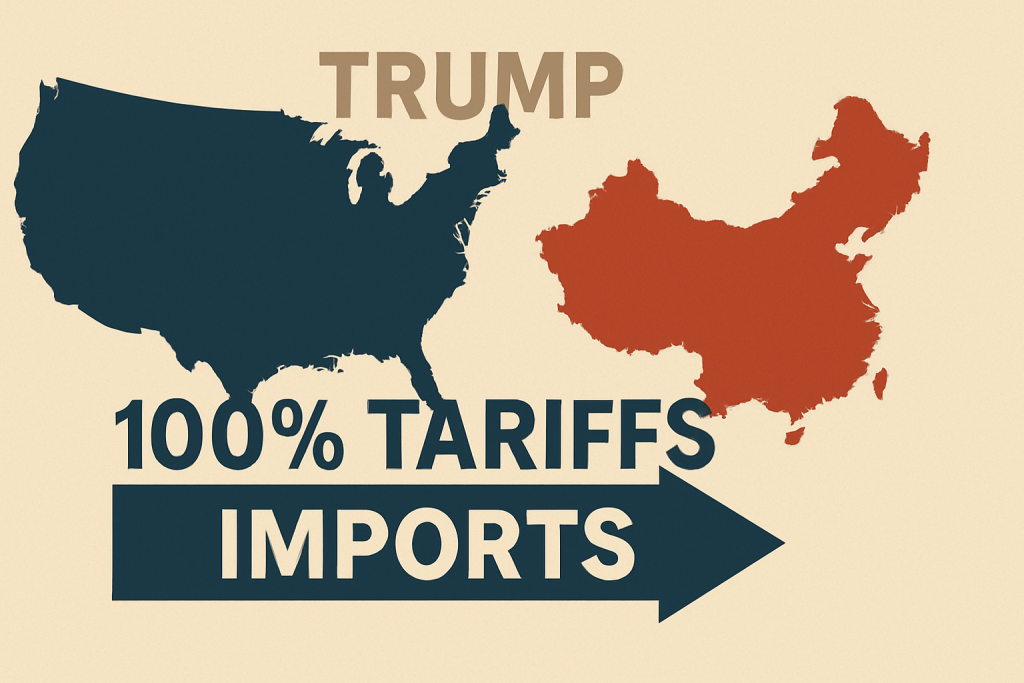
Washington, D.C. — Former U.S. President Donald Trump has renewed a contentious push to impose 100 % tariffs on imports from China, marking a sharp escalation in trade tensions between the world’s two largest economies. The bold plan — if enacted — would dramatically reshape the trade landscape and significantly raise the risk of retaliation or wider economic fallout.
A Return to Hardline Trade Tactics
Trump’s proposal arrives amid speculation about how U.S.–China relations might evolve under his prospective 2025–2029 term. In a public address released late Wednesday, he declared that the current tariff regime has failed to adequately pressure Beijing to change its trade practices and vowed to “reset the relationship” by slapping an across-the-board tax on Chinese products entering the U.S. market.
He criticized the status quo as being full of loopholes and exemptions that allowed some Chinese goods to bypass higher duties, and argued a full 100 % tariff would level the playing field. The announcement immediately triggered anxious reactions in financial markets and attracted sharp scrutiny from trade analysts.
Economic and Political Stakes
If adopted, the move could raise consumer costs, strain U.S. supply chains, and provoke retaliation from China. Many economists warn that such steep duties would reverberate throughout global trade networks, affecting industries far beyond the U.S. and China.
Critics say consumers and American businesses would absorb much of the burden — through higher prices and disrupted access to essential inputs. Proponents, however, argue that the threat of sweeping tariffs might force China to make deeper concessions in areas like intellectual property protection, forced technology transfer, and state subsidies.
Politically, the proposal aligns with Trump’s longstanding “America First” posture and appeals to his core base, which views tough trade stances as central to restoring U.S. manufacturing strength. Some strategists suggest he may calculate that aggressive trade action will resonate with voters in key swing states, particularly if framed as defending domestic jobs against unfair foreign competition.
Possible Reactions from China and the Global Community
Observers predict Beijing would respond swiftly. Chinese state media warned that China “won’t cower under duress” and could retaliate with countermeasures across sectors including agriculture, technology, and autos. A direct tit-for-tat exchange could quickly spiral into a full trade war.
Beyond bilateral dynamics, global economic partners — especially U.S. allies in Europe and Asia — will be closely watching. Some could face pressure to align policies or manage the ripple effects if global supply chains are disrupted. Analysts note that coordinated action among trading blocs may become critical if tensions deepen.
Challenges to Implementation
Putting a 100 % tariff into law would present multiple legal, logistical, and political obstacles. Tariff schedules must be carefully codified; sectors may lobby for exemptions; and enforcement mechanisms would need to be ramped up. Additionally, such a drastic shift could snarl negotiations at the World Trade Organization (WTO) and raise questions about compliance with existing treaties.
Even within U.S. business circles, there is sharp division. Exporters reliant on Chinese components fear supply disruptions, while domestic producers facing Chinese competition might see opportunity. The balancing act would be delicate.
What’s Next
In the coming days, the Trump team is expected to unveil a detailed implementation plan. Key signals to watch include:
- Which sectors will be prioritized or receive temporary exemptions
- Whether China immediately announces countermeasures
- Responses from Congress, especially in trade-sensitive states
- Reactions in financial markets, especially in affected sectors
If the plan proceeds, this could mark one of the most dramatic turns in U.S. trade policy in decades — one that could redefine how global trade will function in the coming era.
